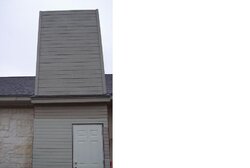- Jan 13, 2007
- 46
elkimmeg said:that stone wall you are cutting a hole threw there is no combustiables on the other side?
the back wall of the chimney box is 34" away...
elkimmeg said:One can not use double wall connector pipe for the chimney. It has to be Class A thate are different types if yours is enclosed in a chase then one can use the cheaper galvanized outer layer Class A and not the more expensive stainless steel.
My mistake.. I thought Class A meant double wall, etc...
I am enclosing in a chase.
However I want to run it horizontal for about 27" Will that be too detrimental?
elkimmeg said:You will soon find out the cost of class A pipe If you use the right pipe it will last a life time. See if Lowes has some hopefully at clearance sale pricing
They had one Cap left.... Rest all Gone!


 )
)

